
- Jul 30, 2025
Botswana’s Import Landscape: Trends, Key Partners, and Strategic Insights
As per the Botswana Import Data by Import Globals, Botswana has used its natural wealth to promote development and raise living standards over the years. Nonetheless, the nation continues to rely significantly on imports to fulfill its industrial and home consumption requirements, making the import industry a vital part of its overall economic structure. Gaining knowledge of Botswana's import patterns might help one better understand its trade partnerships, attempts at economic diversification, and supply chain weaknesses worldwide.
As per the Botswana Export Data by Import Globals, Internal development plans, regional trade dynamics, and changes in the global economy have all influenced Botswana's import landscape between 2020 and 2024. The import data for this time frame shows the continued attempts to diversify the economy beyond mining well as the interruptions brought on by the COVID-19 pandemic and the recovery period that followed. This blog examines Botswana's major product categories, main trading partners, comprehensive import statistics, general economic indicators, and the strategic ramifications of these elements for the nation's long-term economic stability and progress.
General Economic Indicators
Due in large part to its wealth of natural resources and sound fiscal policies, Botswana's economy is regarded as one of the most stable and well-run in Africa. The country has a comparatively high GDP per capita of about $8,000, representing moderate wealth levels compared to many other African countries, with a nominal GDP predicted at about $22.12 billion in 2025. In 2024, as per the Botswana Import Export Trade Data by Import Globals, inflation is predicted to be around 4%, which maintains economic stability and stable consumer spending power. Notwithstanding these advantages, Botswana still faces many obstacles, including a comparatively high unemployment rate of 23.4% in 2023, which emphasizes the necessity of job development and economic diversification.
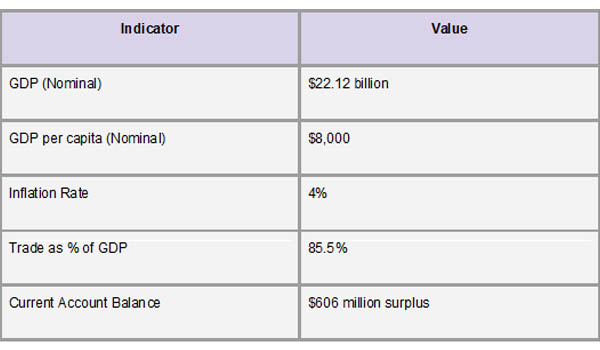
Botswana's economy depends heavily on trade; as of 2022, the total value of imports and exports accounted for approximately 85.5% of GDP. A $606 million current account surplus for the nation in 2022 indicates sound external balances. However, as per the Botswana Import Custom Data by Import Globals, Botswana's strong reliance on imports, particularly from South Africa, a neighbor in the region, highlights certain susceptibilities to supply chain interruptions and external shocks. Together, these economic indicators show how the country is striking a balance between its wealth derived from its natural resources and the pressing need to diversify its economy for long-term, sustainable growth.
Botswana's Import Data
Botswana's import activity fluctuated significantly between 2020 and 2024 due to both domestic and international variables. Approximately $6.52 billion was the import value in 2020, with the COVID-19 pandemic having a significant impact due to its disruption of trade flows and demand reduction. However, as per the Botswana Import Trade Analysis by Import Globals, imports rose to almost $8.40 billion by 2021 as the economy started to recover, indicating a rise in both consumer spending and industry activity. With import values ranging from $6.4 billion to $8 billion, the years 2022 to 2024 showed some stabilization and minor fluctuations, highlighting the need to strike a balance between internal economic diversification initiatives and foreign economic pressures.
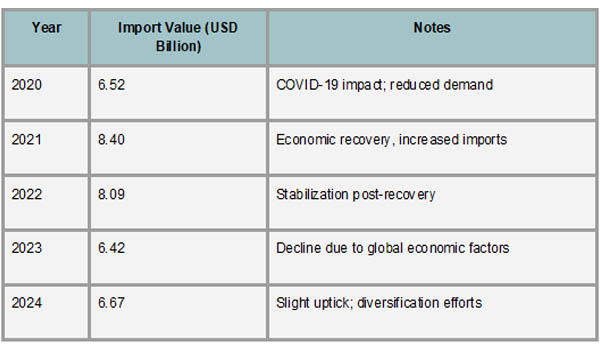
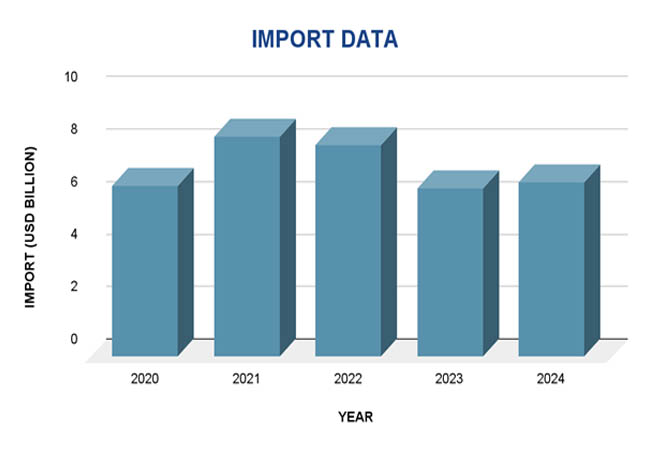 These import patterns demonstrate Botswana's ongoing reliance on imported items, from consumer goods to machinery and energy products, to support its economy. The variations also highlight how susceptible the nation is to changes in commodity pricing and worldwide economic upheavals. As per Botswana Export Data by Import Globals, the import market in Botswana is resilient despite these obstacles, recovering gradually and showing a slight increasing trend until 2024. As firms and politicians plan to increase economic stability and lessen an over-reliance on imports through domestic production and regional trade alliances, this data offers crucial context.
These import patterns demonstrate Botswana's ongoing reliance on imported items, from consumer goods to machinery and energy products, to support its economy. The variations also highlight how susceptible the nation is to changes in commodity pricing and worldwide economic upheavals. As per Botswana Export Data by Import Globals, the import market in Botswana is resilient despite these obstacles, recovering gradually and showing a slight increasing trend until 2024. As firms and politicians plan to increase economic stability and lessen an over-reliance on imports through domestic production and regional trade alliances, this data offers crucial context.
Major Import Product Categories
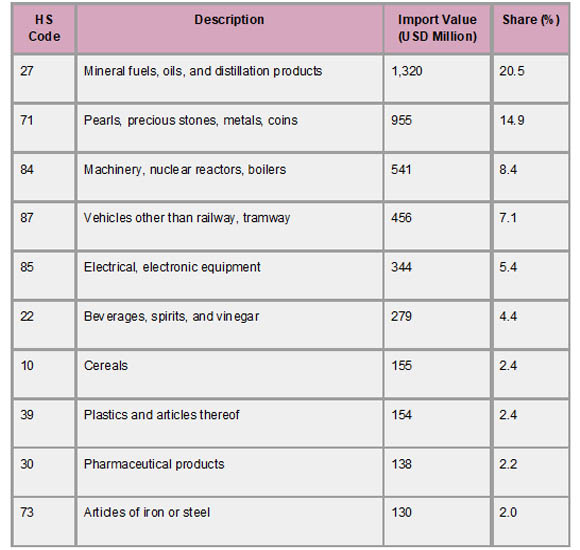
Botswana's import structure is dominated by essential commodities and industrial goods, with mineral fuels and petroleum products (HS Code 27) consistently leading the chart. In 2023, this category alone accounted for over $1.3 billion, making up around 20.5% of total imports. This heavy reliance on imported fuel highlights Botswana’s energy dependency, as the country lacks substantial domestic oil production. As per Botswana Import Data by Import Globals, following closely are imports of pearls, precious stones, and metals (HS Code 71), valued at around $955 million, which support the local diamond processing and jewelry sectors. Other significant import categories include machinery (HS Code 84), vehicles (HS Code 87), and electrical equipment (HS Code 85), all vital for industrial growth and infrastructure development.
Additionally, Botswana imports a wide range of consumer and agricultural products, such as beverages and spirits (HS Code 22), cereals (HS Code 10), and pharmaceutical products (HS Code 30). These items reflect the growing consumer base and the demand for health, food, and lifestyle-related goods. As per Botswana Import Trade Statistics by Import Globals, the diversity in import categories also signals Botswana’s efforts to modernize and expand beyond its mining-dependent economy. However, the dominance of capital-intensive imports suggests a limited domestic manufacturing base, making it imperative for Botswana to invest in local industries to reduce import costs and enhance economic resilience.
Top Import Partners
South Africa continues to be Botswana's top import partner, contributing over 65% of all imports, which were estimated to be worth $4.17 billion in 2023. Geographical closeness, regional trade agreements (such as SACU and SADC), and established supply chains all contribute to this robust trading partnership. As per the Botswana Import Shipments Data by Import Globals, South Africa is an essential economic partner since it mainly provides Botswana with consumer products, machinery, automobiles, and mineral fuels. Botswana also imports goods from other nearby nations, such as Namibia and Zambia, particularly in areas like construction, agriculture, and energy.
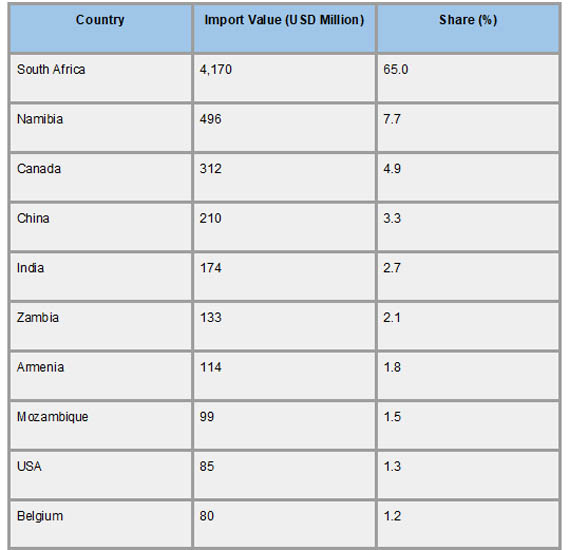
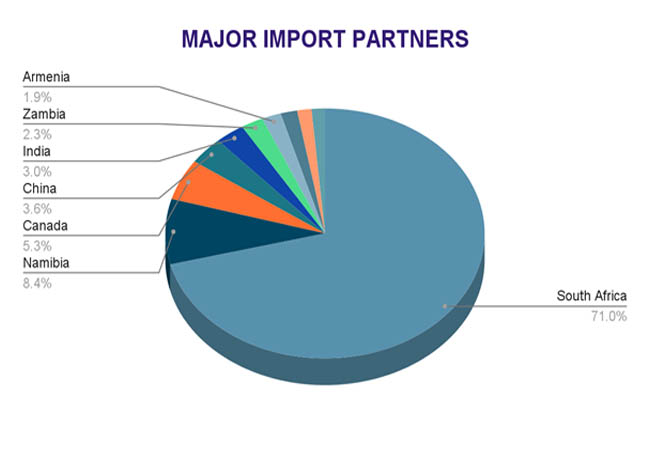
Outside of Africa, nations like the US, Canada, China, and India have a significant impact on Botswana's import profile. As per the Botswana Import Export Trade Analysis by Import Globals, while China and India export consumer goods, textiles, medicines, and electrical goods, Canada provides essential machinery and mining-related equipment. Due mostly to their imports of industrial commodities and precious stones, Belgium and Armenia are also in the top 10. In addition to reflecting Botswana's diverse sourcing approach, this combination of regional and international partners highlights the country's reliance on important suppliers for crucial commodities.
Strategic Implications & Forecast
The import profile of Botswana highlights the country's dependence on basic goods like food, gasoline, and machinery to meet its consumer and industrial demands. This reliance puts the nation at risk of supply chain interruptions and outside economic shocks, especially from neighboring South Africa. Botswana is concentrating on expanding its local production capacity and diversifying its import sources to reduce these risks. As per the Botswana Export Import Global Trade Data by Import Globals, the goal of infrastructure investments like the planned Ponta Techobanine Railway, which would link Botswana and the ports of Mozambique, is to enhance trade logistics and lessen excessive dependence on a single trade corridor.
It is anticipated that Botswana's import growth will follow the course of its economic recovery in the future. The economy is expected to expand by 3% to 4% in 2025 following a recession in 2024, propelled by a recovery in the diamond market and a rise in non-mining sector activity. Demand for imports is expected to increase as a result of this economic recovery, especially for consumer and capital goods. To maintain long-term economic stability, the administration is nevertheless cautious and emphasizes the need for budgetary restraint and sustainable growth.
Conclusion
To sum up, Botswana's import situation between 2020 and 2024 shows a country attempting to strike a balance between trade dependence and economic growth. Although imports are still necessary to meet consumer, industrial, and energy demands, the nation confronts difficulties because of its sensitivity to outside shocks and over-reliance on some partners, such as South Africa. As per the Botswana Import Export Global Data by Import Globals, to increase economic resilience, strategic measures that diversify trade routes, increase domestic production, and strengthen regional collaboration are essential. Botswana is in a good position to maximize its import strategy in line with national development objectives because of its optimistic growth forecasts and emphasis on long-term sustainability.
If you are looking for detailed and up-to-date Botswana Import Data, You Can Contact Import Globals.
FAQs
Que. What is Botswana’s top imported product?
Ans. Botswana’s top imported product is mineral fuels and petroleum products (HS Code 27), primarily sourced from South Africa.
Que. Who is Botswana’s largest import partner?
Ans. South Africa is Botswana’s largest import partner, contributing around 65% of total imports.
Que. What was the total value of Botswana’s imports in 2023?
Ans. In 2023, Botswana imported goods worth approximately $6.42 billion.
Que. Why does Botswana rely heavily on imports?
Ans. Botswana imports many essential goods due to limited domestic manufacturing, especially for fuel, machinery, and consumer products.
Que. What steps is Botswana taking to reduce import dependency?
Ans. The country is investing in infrastructure, energy diversification, and encouraging local production to reduce over-reliance on foreign goods.
Que. Where to obtain detailed Botswana Import Data?
Ans. Visit www.importglobals.com or email info@importglobals.com for more information on up-to-date Botswana Import Data.
